Going with the Floe?
By Stephanie Pfirman, Bruno Tremblay, Charles Fowler
An analysis of luck versus skill in the epic polar expeditions of Fridtjof Nansen and Sir Ernest Shackleton
An analysis of luck versus skill in the epic polar expeditions of Fridtjof Nansen and Sir Ernest Shackleton

DOI: 10.1511/2009.81.484
One hundred years ago, the heroic age of polar exploration was well underway. Expeditions set off one after another to explore, map and make national claims. Fridtjof Nansen and Sir Ernest Shackleton were two of the most renowned polar explorers in their time, and their stories still resonate today.
At first glance the two men and their most famous expeditions were literally poles apart: Nansen, from the not-yet-independent country of Norway, traveled during 1893–1896 to the Arctic, attempting a long-planned sea approach to the North Pole aboard his specially designed ship, the Fram.The goal of Shackleton’s hastily cobbled together British Imperial Trans-Antarctic Expedition of 1914–1917 was to transit to Antarctica in the Endurance and then land a party on the continent who would cross over the ice cap from the Atlantic to the Pacific by way of the South Pole. But the two journeys wound up having much in common. Both ships were frozen into the sea ice and meandered at the whim of the pack, both expeditions spanned three years, both leaders left their crews at some point, and all crew members who sailed with them survived—a highly unusual outcome in that era.
The crucial point that we will explore here is the dependence of both expeditions on their drift trajectory in the sea ice pack and, in Shackleton’s case, the wind and ocean currents of the open sea. These are natural forces, outside the control of the expedition leaders. Were Nansen and Shackleton lucky that the ice and ocean delivered them and their crews to locations from which they could return? Or were their fates predetermined by the normal range of natural conditions? We cannot reconstruct the exact wind and ocean patterns that existed 100 years ago to answer these questions, but using newly available databases, we can look at the patterns of sea ice drift, winds and ocean currents during recent decades to see what is normal and what is not.
“On this same drift-ice, and by this same route, it must be no less possible to transport an expedition.”
—Nansen, Farthest North (1897)

Getty Images
Nansen’s scheme was audacious: He actually planned from the beginning to freeze his ship into the Arctic ice pack north of Siberia and then let the migrating ice transport his party to the North Pole. He got the idea after learning about various materials that were carried by sea ice from Siberia to the coast of Greenland. The most compelling piece of evidence was an Inuit (Eskimo) throwing stick ornamented with Chinese glass beads from the Bering Strait that was found along the west Greenland coast near Gothaab, now known as Nuuk, the capital of Greenland. Driftwood from Siberia was often deposited along the east and west coasts of Greenland. Furthermore, the mineral composition of sediments on East Greenland sea ice was consistent with a Siberian source, and the assemblage of diatoms sampled from drifting ice was similar to that previously sampled near the Bering Strait.
Clearly, a major stream of sea ice flowed consistently from Siberia across the Arctic toward Greenland. Along its way, this route must pass by the North Pole, leading Nansen to state:
I believe that if we pay attention to the actually existent forces of nature, and seek to work with and not against them, we shall thus find the safest and easiest method of reaching the Pole.
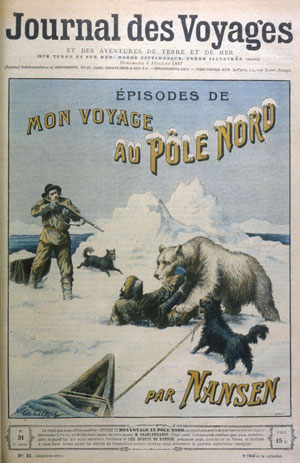
Mary Evans Picture Library/Alamy
While safe and perhaps easy in relative terms, how long would it take to perform this journey? If the drift took ten years, it would be hard to find a crew willing to hitch such a slow ride to the North Pole.
A lucky find of the remnants of a tragedy gave Nansen the last piece of information he needed to propose using the ice drift as the foundation of his North Polar expedition. He wrote:
The Jeanette drifted for two years in the ice, from Wrangel Island to the New Siberian Islands. Three years after she foundered to the north of these islands there was found frozen into the drift-ice, in the neighborhood of Julianehaab, on the southwest coast of Greenland, a number of articles which appear, from sundry indubitable marks to process from the sunken vessel.
The distance from the New Siberian Islands to the 80th degree of latitude on the east coast of Greenland is 1360 miles, and the distance from the last-named place to Julianehaab is 1540 miles, making together a distance of 2900 miles. This distance was traversed by the floe in 1100 days, which gives a speed of 2.6 miles per day. The time which the relics drifted after having reached the 80th degree of latitude till they reached Julianehaab, can be calculated with tolerable precision, as the speed of the above-named current along the east coast of Greenland is well known. It may be assumed that it took at least 400 days to accomplish this distance; there remain, then, about 700 days as the longest time the drifting articles can have taken from the New Siberian Island to the 80th degree of latitude.
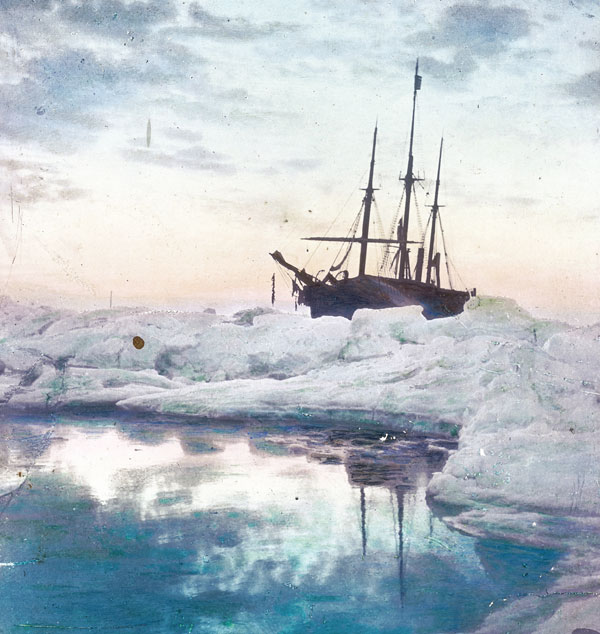
Getty Images
Nansen proceeded to design and build a ship that could withstand the pressures of the ice and outfitted it for five years, more than twice as long as he expected to be drifting within the pack.
The main point in this vessel is that it be built on such principles as to enable it to withstand the pressure of the ice. The sides must slope sufficiently to prevent the ice, when it presses together, from getting firm hold of the hull, as was the case with the Jeanette and other vessels. Instead of nipping the ship, the ice must raise it up out of the water.
With such a ship and a crew of ten, or at the most twelve, able-bodied and carefully picked by me, with a full equipment for five years, in every respect as good as modern appliances permit of, I am of opinion that the undertaking would be well-secured against risk.… When the right time has arrived, then we shall plough our way in amongst the ice as far as we can.
Although many criticized this plan, calling it “sheer madness,” “extremely dangerous,” “based on fallacious ideas,” and leading to “barren results” as well as to “suffering and death among its members,” Nansen persevered in fund-raising and outfitting his expedition. On July 21, 1893, Nansen left Norway and made his way along the coast of Siberia toward the point where the Jeanette had been crushed. Here he maneuvered his ship into the ice and let it freeze around him.
All at once in the afternoon, as we were sitting idly chatting, a deafening noise began, and the whole ship shook. This was the first ice-pressure. Everyone rushed on deck to look. The Fram behaved beautifully, as I had expected she would. On pushed the ice with steady pressure, but down under us it had to go, and we were slowly lifted up.
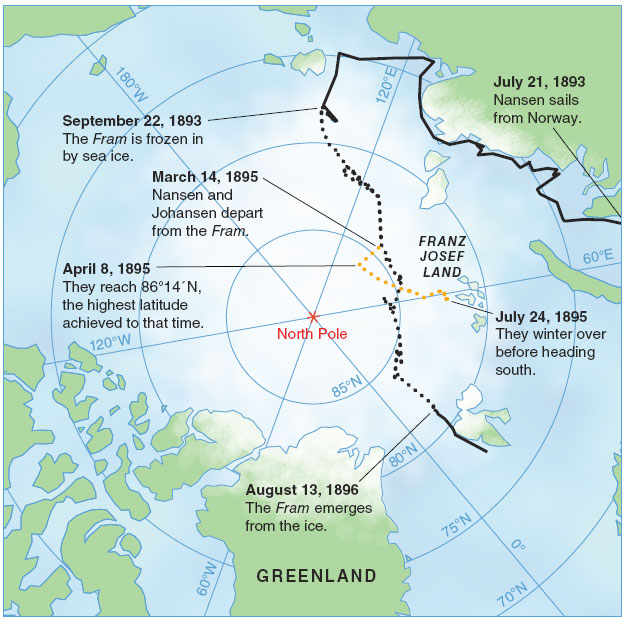
Barbara Aulicino
This first part of the expedition went according to plan, in large part due to the care and time Nansen took in preparing for the expedition. Comparing his expedition with previous ones, Nansen noted:
The present expedition, however, could not be equipped in so short a time [months], and if the voyage itself took three years, the preparations took no less time, while the scheme was conceived thrice three years earlier.
The Fram immediately began drifting with the ice. Each time the ship would loop to the north, Nansen and his crew would celebrate, only to grow despondent when the winds would change and the ship would loop back toward the south. On December 31, 1893—during the first year of drift—Nansen commented:
But you fell off at the end, old year; you hardly carried us as far as you ought. Still you might have done worse; you have not been so bad after all. Have not all hopes and calculations been justified, and are we not drifting away just where I wished and hoped we should be? Only one thing has been amiss—I did not think the drift would have gone in quite so many zigzags.
As time went on, Nansen came to realize that, while the ship was drifting toward Greenland as planned, it was drifting too far south of the North Pole to reach it. On March 14, 1895 (one and a half years later), Nansen left Otto Sverdrup in charge of the Fram and tried to ski to the Pole himself. He took a companion, Fredrik Hjalmer Johansen, three sledges drawn by dogs with provisions for 100 days, two kayaks, a tent and a double sleeping bag. He got as far north as 86°14’ on April 8, 1895. He turned back at this point because he realized that he could not advance as rapidly toward the Pole as he planned: The ice itself was moving south and it was heavily ridged. Nansen and Johansen headed toward the Franz Josef Land archipelago, from where they planned to kayak west to Spitzbergen, now better known as Svalbard. They made landfall on the Franz Josef Land archipelago August 15, 1895, after an amazing 700-kilometer sledge and kayak journey from 85°N to 86°N back to 80°N over ridged ice and open water. They were too late to continue the journey that season so they overwintered in a stone-and-snow hut, living mainly on bear meat. They emerged in the spring of 1896 and continued south through the archipelago, making their way back toward home.
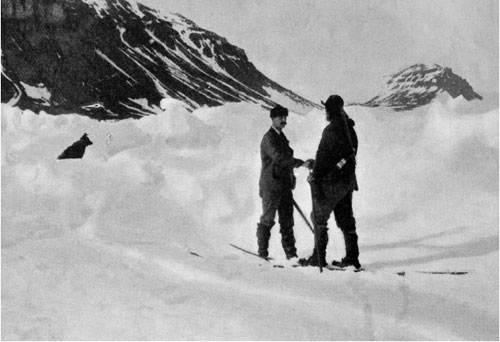
The Mariners’ Museum, Newport News, VA
At this point, one of those coincidences occurred that are so improbable and yet so common in the exploration literature. While planning the expedition, Nansen had turned down a request by Frederick Jackson, an Englishman, who wanted to come along. In response, Jackson decided to put together his own expedition, using Franz Josef Land as a base. According to Roland Huntford, biographer of polar explorers, Jackson had announced his expedition in February 1893, so Nansen would have known about it—and Nansen referred in Farthest North to the “contemplated” Jackson expedition in the area. However, Jackson would write that Nansen was not aware that he would be there. At any rate, Nansen could not have known if the expedition actually happened or where Jackson would set up camp in the maze of islands that make up the Franz Josef Land archipelago. So he was just making his way along the coast, trying to figure out a way to continue on to Spitzbergen, when the following took place (Figure 2):
Suddenly, I thought I heard a shout from a human voice, a strange voice, the first for three years. How my heart beat, and the blood rushed to my brain, as I ran up on the hummock, and hallooed with all the strength of my lungs… Soon I heard another shout, and saw, too, from an ice-ridge, a dark form moving along the hummocks farther in. It was a dog; but farther off came another figure, and that was a man. Who was it? Was it Jackson, or one of his companions, or was it perhaps a fellow-countryman? We approached one another quickly. I waved my hat; he did the same. I heard him speak to the dog, and I listened. It was English, and as I drew nearer I thought I recognized Mr. Jackson, whom I remembered once to have seen.
Nansen joined Jackson’s relief ship back to Norway, arriving on August 13, 1896. When he got there, he found out that the Fram had not yet arrived and he started to grow concerned:
But what of the Fram? I had telegraphed confidently that I expected her home this year; but why had she not already arrived? I began more and more to think over this, and the more I calculated all chances and possibilities, the more firmly was I convinced that she ought to be out of the ice by this time if nothing had gone amiss. It was strange that she was not already here, and I thought with horror that if the autumn were to pass without news of her, the coming winter and summer would be anything but pleasant.
Fortunately, exactly one week after his arrival, on August 20, 1896, Nansen got a telegram from Sverdrup saying that the Fram was out of the ice and that the crew were all fine. The Fram’s closest approach to the North Pole turned out to be 85°56’N (85.93°N)—just 18’ south of the northern point of Nansen (86°14’). Another coincidence was that the Fram had emerged from the ice between Greenland and Svalbard, through what is now known as Fram Strait, on exactly the same day that Nansen had arrived in Norway, August 13, 1896.
Nansen was hailed as a hero in Norway and around the world. However, there were some detractors who focused on Nansen’s leaving the Fram and striking out on his own toward the Pole. Nansen himself quoted one of them in his introduction to Farthest North:
“… It passes comprehension how Nansen could have thus deviated from the most sacred duty devolving on the commander of a naval expedition. The safe return of brave Captain Sverdrup with the Fram does not excuse Nansen.”
Others rose to support Nansen in the face of this criticism.
In the light of this controversy, what would have happened if the Fram had taken longer to drift out of the Arctic pack ice? It was wonderful that she arrived in Norway only one week after Nansen. What if she came out of the ice one year later? Or even more? Was Nansen just lucky that she emerged when she did?
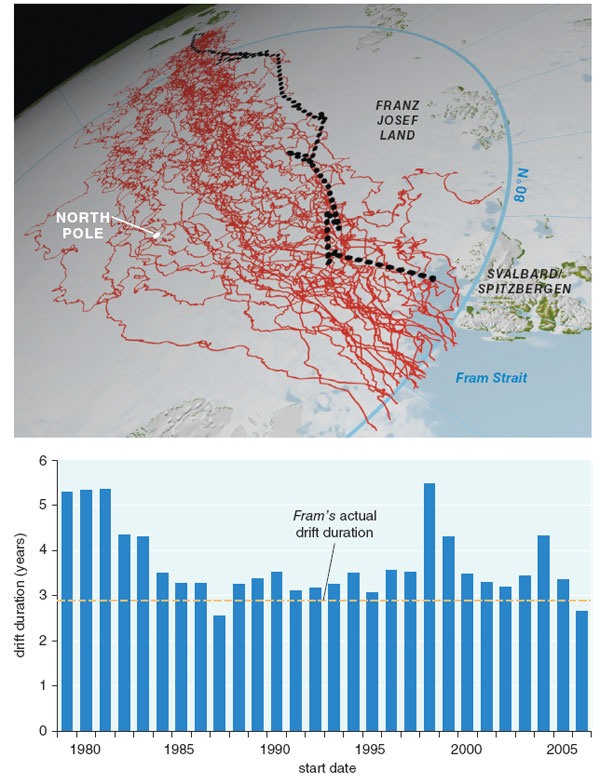
Barbara Aulicino and Morgan Ryan
texture map by Planetary Visions Ltd
Also, how would things have been different if the Fram had attained the North Pole? Was Nansen unlucky that the drift was too far south, or is that the usual path that the sea ice takes from the location where he started?
To address these questions, we used a computer program called Ice Tracker to assess the drift trajectory each year from 1979 to 2006. Ice Tracker, a project that originated at the Colorado Center for Astrodynamics Research, University of Colorado at Boulder, is a web-based tool that allows users to reconstruct the drifting of sea ice in the Arctic and Antarctic, based on 30 years of satellite and buoy data. Starting at any time and location where there is sea ice, Ice Tracker pinpoints the daily changes in the location of the drifting ice.
For our drift start point we used the location and date that the Fram was frozen into the ice (September 22 at 78°42’N and 133°35’48”E). We must acknowledge that Nansen had to make his way along the Siberian coast to get to this point, and that some years the sea ice conditions would have been too difficult to make that trip possible. Thus, he might have made different choices about where to freeze in the ship, depending on the sea ice conditions he encountered along the shelf.
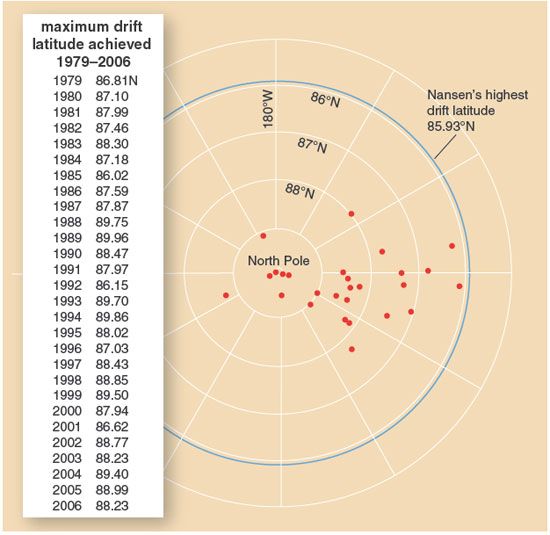
Morgan Ryan and Barbara Aulicino
Our analysis indicates that, using Nansen’s start location and ending the drift at 40 percent ice concentration or when the ship would have emerged through Fram Strait at 80°N, the average drift duration of the Fram from 1979 through 2006 would be 3.7 years with a standard deviation of 0.8 years (Figure 5). Fram’s actual drift rate was 2.9 years (9/22/1893 to 8/13/1896, the date the ship emerged from the pack). Only two years had drift durations less than 3 years (2.5 years in 1987 and 2.6 in 2006). There were four start years with drifts longer than five years (1979, 1980, 1981 and then again in 1998). Nansen had provisioned the ship for five years and could supplement the ship’s stores by hunting and fishing, so the crew would probably have survived even these extended voyages.
The average maximum latitude of the simulated trajectories was 88°6’N (standard deviation of 1.1°) which is 240 kilometers closer than the 85°56’ that the Fram attained in 1895. In fact, every year since 1979, the Fram would have been just about as close (86°1’N in 1985) or closer to the Pole than it was during the 1893–1896 drift (figure 6). Roger Colony in an unpublished analysis found a similar result using computer modeling: The Fram would have passed closer to the Pole for nine out of ten possible drifting paths. Our analysis indicates that in 1988, 1989, 1993, 1994, 1999 and 2004 the Fram’s drift would have taken it north of 89°N. The best year for Nansen would have been 1989: the ship would have gotten to 89°58’N (89.96°) and still would have emerged within 3.3 years (Figures 3 and 4).
If Nansen had been able to maneuver the Fram slightly more to the east before freezing her in, the average sea ice drift would have taken her even closer to the Pole. The 2006 Tara expedition did freeze in to the east (79°53’N, 143°E) and reached a more northerly latitude than did the Fram: 88°32’N (160 kilometers from the geographic North Pole). But the most remarkable aspect of the Tara expedition was its extremely short drift duration, only 461 days—1.3 years!—to reach 80°N in Fram Strait. This faster drift rate was likely due to decreased resistance of the sea ice to wind forcing caused by less extensive sea ice conditions, and the presence of younger, thinner ice than that which Nansen encountered.
If Nansen had initiated his expedition during conditions like those that occurred in 1979 through 1983 or 1998, he may have realized that the drift was going too slowly, putting the future of the expedition in jeopardy, and he might have decided that it was not safe to leave the crew of the Fram. If, however, he had left the ship and made it back safely to Norway, he definitely would have faced difficult circumstances as he waited month after month and then year after year for the Fram to return.
I have often marveled at the thin line that divides success from failure and the sudden turn that leads from apparently certain disaster to comparative safety.
—Shackleton, South (1919)
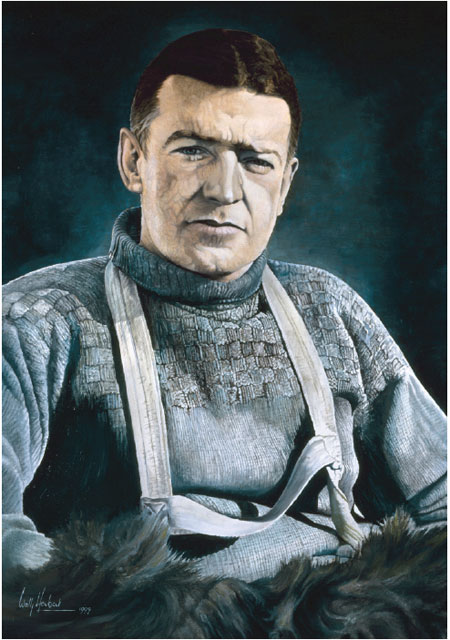
Robert Harding Picture Library Ltd/Alamy
Unlike Nansen, Shackleton did not want to be caught in the ice—far from it. He planned for a shore party to be dropped from his ship, the Endurance, at Vahsel Bay where Filchner had attempted a landing in 1912. Shackleton would then attempt to cross the continent, meeting up with the Ross Sea party which was laying depots from the other side to assist his crossing. But when he arrived at South Georgia, his last port of call, the whaling captains told him of the terrible ice conditions that existed that year “… the worst they had ever been in the memory of the Norwegian whaling skippers operating in the area.” Some even advised him not to pursue the expedition that year. He spent a month in South Georgia hoping the conditions would get better and learning from the whalers about the local environment. Then he decided to see for himself, departing from South Georgia on December 5, 1914, to make his way south into the ice. Endurance worked through openings in the floes until eventually Shackleton was just over 100 kilometers away from his coastal goal of Vahsel Bay.
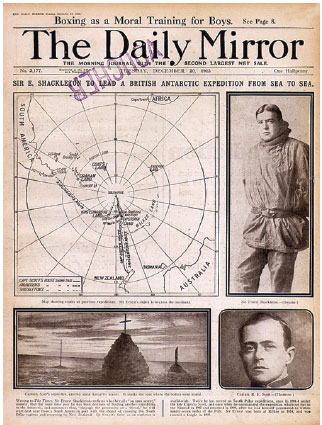
Trinity Mirror/Mirrorpix/Alamy
At this point, Shackleton’s luck turned. A storm came up with winds from the northeast, pushing the pack ice together against the shore and dumping snow into the water around the ship. By January 19, 1915, the Endurance was stuck in the ice at 76°34’S, 31°30’W. Later efforts to maneuver out of the pack were not successful. The ship was “frozen,” as crew member Thomas Orde-Lees put it, “like an almond in the middle of a chocolate bar.” As conditions were fairly comfortable on the ship, and as it was drifting with the ice to the north, Shackleton made the best of the situation, with fun and games on board. He knew from his conversations with the whalers on South Georgia that “great quantities of ice sweep along the coast from the east under the influence of the prevailing current, and fill up the bight of the Weddell Sea as they move north in a great semicircle.”
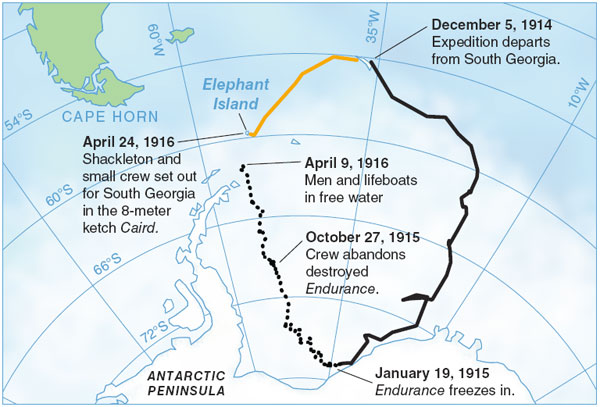
Barbara Aulicino
On October 27, 1915, ten months after freezing in, the Endurance was crushed, leaving 28 men with three lifeboats camping on the ice. Shackleton: “We are alive and well, and we have stores and equipment for the task that lies before us. The task is to reach land with all the members of the expedition. It is hard to write what I feel.” Fortunately, their drift continued to the north, finally dumping the men in their lifeboats into the ocean on April 9, 1916, at the marginal ice zone near the tip of the Antarctic Peninsula.
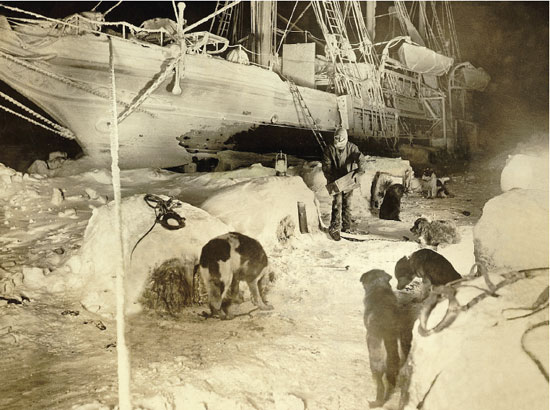
Underwood & Underwood/Corbis
From here, Shackleton, with the guidance of his navigator, Worsley, set sail for Elephant Island, the nearest attainable land mass. They made landfall with all crew still alive after a hard, six-day, 150 kilometer journey in freezing conditions in an ice-riddled sea, with high waves and difficult landings.
Now on land, they were still not safe. The shore of Elephant Island was exposed to strong winds and storms and was so out of the way that no one would look for them there. Shackleton requested that the carpenter ready their biggest boat, the Caird, a 22.5-foot (8 meter) ketch, so that he could go for help. (It was not possible to make all three of their boats seaworthy.) Together with Worsley and four others, Shackleton set sail on April 24, 1916, for South Georgia, 1,300 kilometers away to the east. Although Cape Horn of South America was closer in distance, only 900 kilometers to the north, the strong Antarctic Circumpolar Current running from west to east made it impossible to reach.
According to Worsley, by the first evening of the boat journey they still had not decided where to go:
Again and again we discussed the best point to make for, Shackleton emphasizing once more that he wanted to get to the north as quickly as possible, even though the route might be lengthened, so as to avoid all danger of ice and to relieve us from the almost overwhelming cold.
“What do you think about Cape Horn?” he asked, adding, “it’s the nearest.”
“Yes, I replied, “but we can never reach it. The westerly gales would blow us away. With luck, though, we might fetch the Falkland Islands.”
“I am afraid that, although it is the longest run,” he remarked, “we shall have to make for South Georgia as you originally suggested. The gales will drive us to leeward.”
Over 16 days, with only a few navigational sightings, Worsley steered and sailed the ship toward South Georgia, an island 170 kilometers long. After a harrowing open-sea journey transiting a region with some of the worst wave conditions in the world, they caught sight of land. Just then a terrible storm rose up with hurricane force winds that almost dashed their boat against the rocky shore. They finally made landfall on South Georgia the next day, May 10, 1916, an almost unbelievable feat of navigation and endurance.
Having accomplished the amazing, they now faced another dilemma: The whaling village was on the other side of the island and their boat was too battered to sail more than 150 kilometers around. Shackleton decided that their only chance was to walk across the island, a straight line distance of 50 kilometers. They knew that the trek would be more grueling than that because running down the center of the island was a spine of mountains, some over 2,000 meters high. The carpenter took two-inch brass screws from the Caird and put them into the soles of their shoes, eight in each foot, to give them a better grip on the ice. They didn’t take a tent or sleeping bags, just food for three days—they had to go as fast as possible, without sleeping, or they would never make it. No one had ever crossed the island this way before, but they did, in just 36 hours.
On his fourth attempt, Shackleton finally got through the sea ice and rescued his men from Elephant Island on August 30, 1916. He then proceeded to help rescue the Ross Sea party, returning the remainder of the Imperial Transantarctic Expedition back to New Zealand on February 9, 1917.
What were the alternative fates for Shackleton and his crew? What if the sea ice drift had not taken them to Elephant Island but had instead taken them eastward, out into the Antarctic Circumpolar Current and far from any landfall? Further, what if Shackleton’s boat journey had not been successful in locating South Georgia?
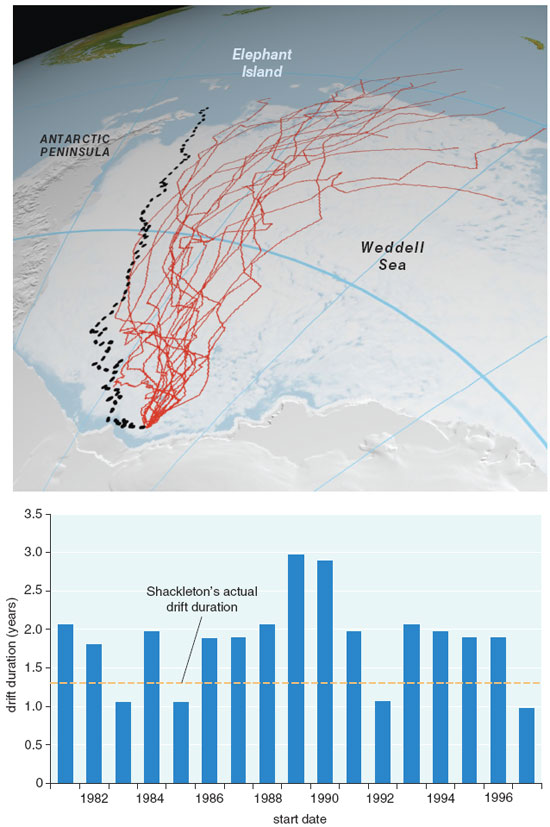
Barbara Aulicino and Morgan Ryan
texture map by Planetary Visions Ltd
Here we approach these questions in two different ways, one using the Ice Tracker for the sea ice drift, as we did for Nansen, and the other looking at the ocean segment of the boat journey using a high-resolution coupled ice-ocean model forced with observed winds and other atmospheric fields from the National Centers for Environmental Prediction–National Center for Atmospheric Research. In this model, the Shackleton boat journey was simulated as a passive drifter under the action of winds and ocean currents. The drag coefficient between the water and boat was set based on an estimated draft and surface area of the ship, but the results proved to be not sensitive to the exact value of this variable. The effect of the winds on the ship drift was parameterized in such a way as to obtain a total drift distance of 1,300 kilometers in the 16 days that Shackleton required to cross the passage. In the model no attempt was made to reproduce sailing upwind or crosswind; the ship just sails downwind while also being affected by the eastward ocean drift. The resulting trajectories indicate how much active sailing was required on the part of the crew.
The Ice Tracker’s re-creations of drifts were each started where Shackleton froze into the ice and were terminated at either 0 percent sea ice concentration, or when the concentration was at 40 percent for more than one month, whichever came first. Like the projections for the Nansen expedition, in the years since 1981, the ice drift duration would generally have been longer than the 1.3 years that Shackleton actually experienced: the average is 1.8 years (standard deviation 0.6 years), with a maximum in 1989 of 3.0 years (Figure 10). Drifting for such a long time on the ice would increase the crew’s dependence on success in hunting and fishing and would also take a psychological toll. The four years with shorter drift durations (averaging 1 year in 1983, 1985, 1992 and 1997) are interesting because they reached low ice concentrations at about the position that the Endurance was crushed (she was crushed at 69°5’S and the average termination latitude for these four years was 69°42’S). This means that she might have been released with so little damage that she could have sailed back to port, as Sverdrup did with the Fram in the Arctic.
If the men were in lifeboats when the ice melted out at this southerly location, they would face difficulties, as they attempted “… to row north-west to where we might find land …” (Shackleton). This conclusion is reinforced by the most surprising aspect of the simulated trajectories: Not one of them headed toward Elephant Island at 61°10’S, 55°14’W. All of the terminations were farther to the east than Shackleton’s expedition.
Eastward drift was Shackleton’s nightmare: “The land lay to the west, so had we drifted to the east we should have been taken right away to the centre of the entrance to the Weddell Sea, and our chances of finally reaching land would have been considerably lessened.” The reason why successful landfall would be difficult is that the lifeboats had to be overloaded to accommodate the men and necessary stores, and they would have had to beat upwind, as well as upcurrent, against the strong eastward flowing Antarctic Circumpolar Current—an impossible task.
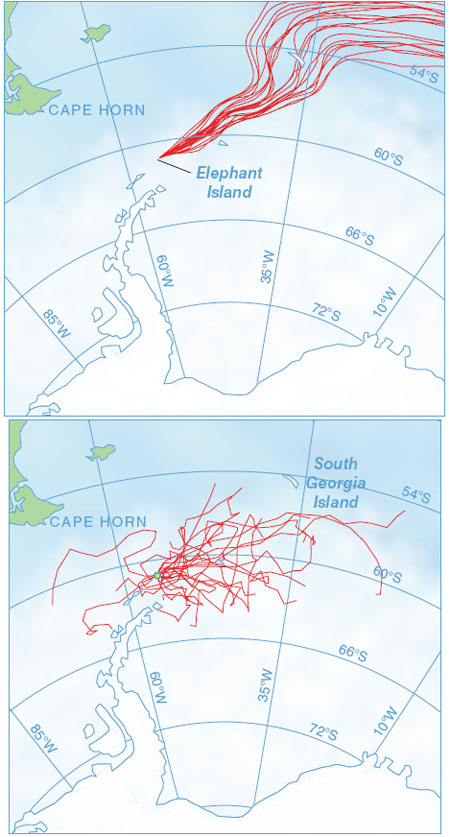
Barbara Aulicino
But the easterly drifts also have another implication: Again, they could mean that the Endurance might not have been crushed. If the ship had drifted north along the marginal ice zone, and not in the interior of the pack, the compression forces driven by wind pushing ice against the Antarctic Peninsula would likely have been smaller. The thicker multiyear ice floes that collect along the Peninsula also pose a greater crushing hazard than does the thinner, younger ice along the edge.
In exploring the fate of the ocean journey between Elephant and South Georgia Islands, we ask the question, how important was Worsley’s navigation? What would happen if the boat just drifted away from Elephant Island, like a corked bottle or a piece of driftwood? Where would it end up? Would it have come close to South Georgia? There is a hint in Worsley’s book about the expedition that this might be the case. He describes their camping place on South Georgia as an area where driftwood converged—note how similar the description is to Nansen’s analysis of the constancy of the Arctic sea ice drift that brought the Siberian throwing stick, driftwood, sediments and biological materials as well as remnants of the shipwrecked Jeannette to the coast of Greenland:
Close to the boat was a great pile of driftwood, about half an acre in extent—a graveyard of wreckage from ships. In places it was piled eight feet high or more, and there were ships’ masts and timbers, a great mainyard, bits of figureheads, teak stanchions with brass caps, cabin doors, binnacle stands, broken oars, and harness casks. These had been swept from before the westerly gales a thousand miles from Cape Horn, or farther, until the wild Southern Ocean had, by some strange freak of its eddies, thrown them up here to rot.
This passage seems to indicate a steady delivery from the Antarctic Circumpolar Current to this location, which collected floatsam from a wide swath of the ocean. Indeed, the ocean model shows that the ocean current alone would carry Shackleton to the vicinity of South Georgia most of the time (Figure 11, top). But it would take at least 90 days! Shackleton had taken enough food to sustain six men for only a month. It actually took them 16 days, but because one of their water containers became contaminated with seawater, even a slightly longer journey would have threatened their survival.
Shackleton got to South Georgia faster than 90 days because he sailed. Of the roughly 80 kilometers of travel that he averaged per day, about 10 to 15 kilometers per day came from the ocean current, and for the remaining 60 plus kilometers per day he depended on the winds and sailing. Sailing 80 kilometers per day (3 kilometers per hour) is well within the normal speed range of a sailboat. The winds observed on the boat journey often came from the west but shifted direction frequently, as was also seen in our 1979 through 1999 analysis (Figure 11, bottom). The fact that Worsley managed to make landfall on South Georgia in the face of this variability in the winds, as well as high seas and storms, using only a compass and a few navigational sightings, makes his navigational feat even more admirable.
Both Nansen and Shackleton were lucky and unlucky in the natural conditions that they encountered during their expeditions. Most years since 1979, Nansen would have gotten much closer to the North Pole than he did in 1895, so he was unlucky in that respect. On the other hand, the Fram emerged from the pack 2.9 years after freezing in, nearly a year faster than the average time since 1979 of 3.7 years, indicating that the expedition was lucky in their drift rate. This is especially true of the years 1979 through 1981, and 1998, when the drift duration was more than 5 years.
Shackleton was also lucky in the rapid pace of his drift in the pack—at 1.3 years it was half a year shorter than the average of 1.8 years. The fact that his trajectory was so close to the Antarctic Peninsula is particularly interesting: all drifts since 1981 were farther to the east. If the Endurance had actually drifted along the eastern border of the pack ice, it might not have been crushed, and they might have been able to sail it back to port, as Sverdrup did with the Fram.
Shackleton’s journey from Elephant Island to South Georgia in the lifeboat was quite extraordinary in the face the variable winds in the region. While the ocean currents would have taken him in a similar direction if he had just drifted, it would have taken far too long for them to survive—three months. Also, importantly—no one knew the details of the ocean currents at the time. Shackleton made the decision to go for help because he had to. They headed for South Georgia because they knew that it was both inhabited and downwind.
Subsequent attempts to recreate the boat journey and the crossing of South Georgia have encountered so many challenges that the participants gain new respect for Shackleton:
‘Unfavorable gale force winds, the unbelievably cramped conditions on board, the cold, the ever present penetrating dampness, and then the violent rocking of the boat in the churning sea, put an enormous strain on the strength of the crew’.… The difficulty of these expeditions should not be underestimated. The South Aris team had to abandon their replica boat after force 10 storms rolled it repeatedly, while Wake expedition members failed to traverse South Georgia and the Memorial expedition couldn’t manage the island landing.
Analyses such as these, including the unpublished Nansen’s Luck by Roger Colony, and Susan Solomon’s determination of the actual environmental conditions during the Amundsen-Scott race to the South Pole, reported in The Coldest March (2001), help set history and profiles of leadership within a scientific framework, and aid in understanding the role of the environment, environmental variability and environmental change.
Click "American Scientist" to access home page
American Scientist Comments and Discussion
To discuss our articles or comment on them, please share them and tag American Scientist on social media platforms. Here are links to our profiles on Twitter, Facebook, and LinkedIn.
If we re-share your post, we will moderate comments/discussion following our comments policy.